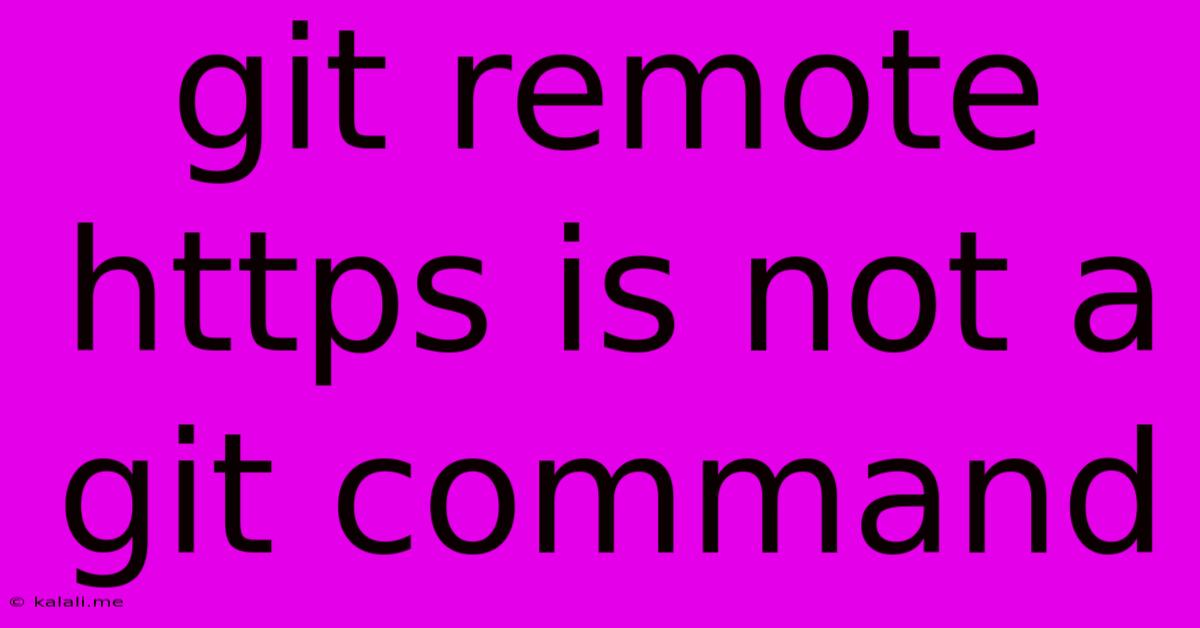Git Remote Https Is Not A Git Command
Kalali
Jun 11, 2025 · 3 min read

Table of Contents
Git Remote HTTPS: Not a Command, But a Connection
The error message "git remote https://..." is not a Git command often pops up when users are trying to interact with their remote repositories. It's not about a faulty command itself, but rather an incorrect usage of the git remote command. This article will guide you through understanding the problem and provide solutions to effectively manage your remote repositories. This will cover common mistakes, proper syntax, and best practices.
This error arises because you're trying to use a URL directly with the git remote command. The git remote command is used to manage names of remote repositories, not their URLs directly. It's like trying to call someone by their full address instead of their name; it won't work. Understanding this distinction is crucial.
Understanding Git Remotes
A Git remote is essentially an alias for a repository's URL. Think of it as a nickname – it simplifies referencing a potentially long and complex URL. You use this nickname to interact with the remote repository (e.g., fetching updates, pushing changes). Common names for remotes are origin (the default name often assigned during repository cloning), upstream, or any descriptive name you choose.
Correct Usage of git remote
The proper way to interact with a remote repository involves several steps:
-
Adding a remote: This is where you associate a name with the URL. The correct command is:
git remote addReplace
<name>with a descriptive name (e.g.,origin,upstream,github) and<url>with the HTTPS URL of your remote repository (e.g.,https://github.com/username/repository.git). For example:git remote add origin https://github.com/username/repository.git -
Listing remotes: To see the remotes currently configured, use:
git remote -vThis will show you the fetch and push URLs associated with each remote.
-
Removing a remote: If you need to remove a remote, use:
git remote remove -
Working with the remote: After adding a remote, you can use commands like
git fetch <name>andgit push <name>to interact with it, using the name you assigned, not the URL directly.
Troubleshooting and Common Mistakes
- Incorrect URL: Double-check that the HTTPS URL you're using is correct and includes the
.gitextension. - Typographical errors: Carefully review your commands for typos. A small mistake in the remote name or URL will lead to errors.
- Existing remote: Ensure you're not trying to add a remote with a name that already exists. Use
git remote -vto check your existing remotes first. - Permission issues: If you're encountering authentication errors, verify your credentials and ensure you have the necessary permissions to interact with the remote repository. Consider using SSH keys for a more secure and seamless experience.
Best Practices
- Use descriptive remote names: Choose names that are meaningful and easy to remember.
- Check your remotes frequently: Use
git remote -vregularly to ensure your remotes are correctly configured. - Consider using SSH: For increased security and to avoid constantly entering your username and password, consider setting up SSH keys for authentication. This will provide a more streamlined workflow.
By understanding the correct usage of git remote and avoiding common pitfalls, you can effectively manage your remote repositories and avoid the "git remote https://..." error. Remember, git remote manages names, not URLs directly. Use the name you've assigned to your remote when performing fetch and push operations.
Latest Posts
Latest Posts
-
How Many Pounds Are In 2 5 Kg
Jul 01, 2025
-
Which Is Greater 2 3 Or 2 4
Jul 01, 2025
-
How Do You Pass Level 7 On Bloxorz
Jul 01, 2025
-
If Your 13 What Year Were You Born
Jul 01, 2025
-
How Many Cups Is 3 Liters Of Water
Jul 01, 2025
Related Post
Thank you for visiting our website which covers about Git Remote Https Is Not A Git Command . We hope the information provided has been useful to you. Feel free to contact us if you have any questions or need further assistance. See you next time and don't miss to bookmark.